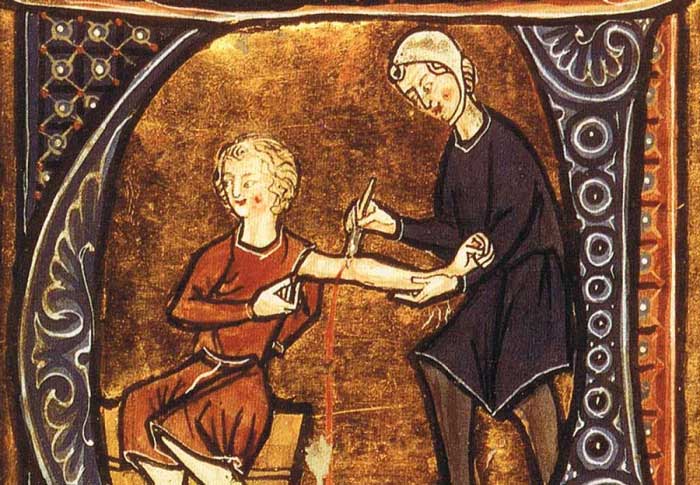How did ancient people treat cancer, a disease that remains extremely complex even for modern medicine? In recent years, more scholars have been researching the methods of diagnosing and treating cancer in ancient times.
The Foundations from Hippocrates
Medicine first mentioned cancer around 1600 BC. At that time, the term karkinoma was used to describe incurable tumors that arose in some patients. Hippocrates, the Greek physician known as the father of medicine (460 – 370 BC), was the first to observe and document these tumors and named them.
Other doctors of that era believed in Hippocrates’ humoral theory, positing that various diseases were caused by an excess of different types of bile. For Hippocrates and his contemporaries, cancer was due to patients having “too much black bile.” Common treatments included bloodletting, laxatives, or dietary changes. There is no evidence of any tumor removal surgical techniques at this point in history.

From the theory of four types of bile in the body, ancient doctors believed that excess bile was the cause of cancer.
Following Hippocrates, between 25 BC and 50 AD, Aulus Cornelius Celsus, a Roman physician and encyclopedist, adopted Hippocrates’ term for this condition, “carcinoma” (epithelial cancer), and translated it into Latin as “crab.” The term “crab” persists to this day and is translated as “cancer” in modern languages. Aulus Cornelius Celsus was the first to document the spread of cancer, even detailing how breast cancer could spread from the breast to the armpit in some patients. He also classified different cancers based on their severity and physical characteristics, describing the presence of cancers in all parts of the body, including the face, mouth, throat, breast, liver, colon, etc.
However, it took several decades after both Hippocrates and Celsus for advancements in cancer treatment to begin to emerge. Archigenes, a Greco-Syrian physician in the 1st and 2nd centuries AD, was the first to attempt surgical removal of cancer in his patients. Oribasius, another physician, described this surgical method, emphasizing that it required early diagnosis and the need to avoid any nerves surrounding the tumor. He also described methods of cauterizing tumors to prevent recurrence, as well as postoperative treatments to prevent infection, including the use of poultices, salts, leeks, and other astringents.
Treatment Techniques
Claudius Galen, a Greek physician in the 2nd century AD, continued to develop the theories and treatment methods of Hippocrates and Archigenes. Based on Hippocrates’ humoral theory, he also believed that cancer was caused by an excess of black bile. Specifically, Galen believed that black bile was produced by the liver and accumulated over time due to lack of processing by the spleen. Galen also posited that black bile led to incurable cancer while yellow bile resulted in curable cancer. This may have been the first time an ancient physician identified the difference between malignant and benign tumors.
Galen claimed to have observed many cases of “excess black bile” causing cancer in the breast tissues of premenopausal women. He detailed the process of excising these tumors, stating that he would remove the tumor and a bit of surrounding tissue, then cauterize the base of the tumor to prevent it from regrowing. He also noted the importance of early treatment with purgatives to try to eliminate black bile. Only when there were no other treatment options would he resort to the final measure of surgical excision.
Leonides, a Greek physician who lived in the same century as Galen, frequently referred to Galen’s works to analyze and treat various cases of breast cancer. However, Leonides believed that surgery should be performed early rather than being considered a last resort. His records describe several cases of total mastectomy being performed as early as possible to treat breast cancer in women.
Additionally, Leonides described some cases of breast cancer in men, which were rarer, as well as the different ways breast cancer could manifest in different patients. He was the first to identify a retracted nipple as a sign of breast cancer. The cauterization methods in Leonides’ surgeries were primarily to prevent hemorrhage, but also served to remove any remaining traces of cancer from the body after mastectomy. Leonides believed that cauterizing the entire area just excised along with the tumor would prevent recurrence.
Finally, Paulus Aegineta, a physician and encyclopedist in the 7th century AD, further described findings related to cancer treatment. Aegineta primarily followed Galen’s theories, except he believed that one should not cauterize the entire surgical area as it would cause significant long-term harm to the patient by delaying wound healing and increasing the risk of infection. Aegineta believed that cauterization should only be used to lightly destroy the roots of the tumor. Even in cases of hemorrhage, Aegineta was very limited in his use of cauterization during surgeries.
For Aegineta, non-ulcerated tumors (under the skin, or presumed to be within an organ such as the uterus) were too dangerous and had too high a risk of mortality to undergo surgical procedures. Therefore, like Hippocrates and Galen, he focused on treatment methods aimed at expelling “black bile” to treat these patients.
Subsequently, physicians following Hippocrates, Archigenes of Apamea, and Galen continued to treat based on the methods of their predecessors. They persisted in believing that black bile was the cause of cancers (sometimes they used the foul-smelling secretions from tumors as evidence for this hypothesis), and sought various ways to improve surgical techniques for removing tumors from different parts of the body.
Overall, most ancient surgeries only dealt with tumors visible to the naked eye. Given the medical knowledge of the time, deeper surgical procedures were too dangerous and had high mortality rates. It wasn’t until recent centuries that more advanced cancer treatment methods emerged.
Fortunately, thanks to scanning devices and sampling techniques, modern medicine can accurately diagnose tumors in all parts of the body, and in most cases, can provide intervention measures.



















































